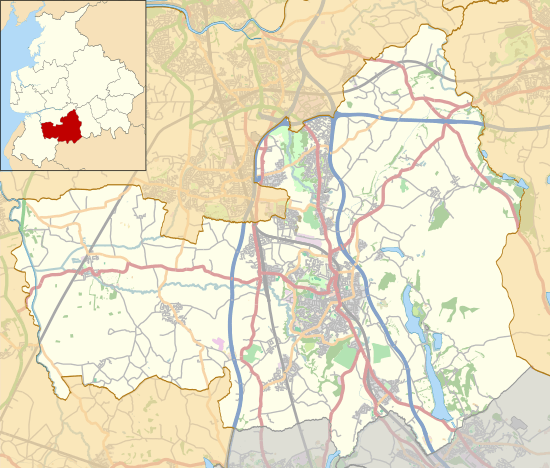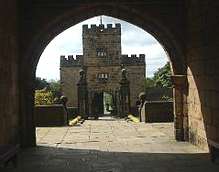Hoghton Tower
| Hoghton Tower | |
|---|---|
 | |
| Location | Hoghton, Lancashire, England |
| Coordinates | 53°43′58″N 2°34′25″W / 53.7329°N 2.5735°WCoordinates: 53°43′58″N 2°34′25″W / 53.7329°N 2.5735°W |
| OS grid reference | SD 623,264 |
| Elevation | 560 ft (170 m) |
| Built | c, 1560–65 |
| Built for | Thomas de Hoghton |
| Restored | 1862–1902 |
| Restored by |
Sir Henry de Hoghton Sir Charles de Hoghton |
| Architect |
Paley and Austin, James Bertwistle, Robert Dudley Oliver |
Listed Building – Grade I | |
| Designated | 22 October 1952 |
| Reference no. | 1072532 |
 Location in the Borough of Chorley | |
Hoghton Tower is a fortified manor house located about 0.7 miles (1 km) to the east of the village of Hoghton, Lancashire, England, and standing on a hilltop site on the highest point in the area. It takes its name from the de Hoghton family, its historical owners since at least the 12th century. The present house dates from about 1560–65. It was damaged during the Civil War and subsequently became derelict, but was rebuilt and extended between 1862 and 1901. The house is listed at Grade I, as is the Great Barn in its grounds, which is dated 1692. Also in the grounds are two structures listed at Grade II. The house and garden are open to the public at advertised times, and are administered by a charitable trust.
History

The land on which the house stands has been in the possession of the de Hoghton family from at least the 12th century. The present building dates from about 1560–65, and was built for Thomas de Hoghton, replacing an earlier house on or near the same site. It has been suggested that the property has links to William Shakespeare through Alexander Hoghton who died in 1581.[1][2]
King James I stayed in the house for three days in 1617.[lower-alpha 1] In 1643 the house was damaged by Parliamentary forces during the Civil War, and in 1692–1702 Sir Charles de Hoghton carried out repairs and rebuilding. The family ceased to live in the house from 1768, and it was rented to local farmers.[4] It was derelict by the middle of the 19th century.[5] Sir Henry de Hoghton, the 9th Baronet, inherited the estate in 1862 and decided to restore the house. It is not known who carried out the earlier part of the restoration, but by 1876 the Lancaster architects Paley and Austin were involved, having carried out work on rooms including the banqueting hall. Sir Henry died in 1876, and restoration work was continued by his brother, Charles, the 10th Baronet, although the house was not ready for him to take up residence until 1880. By that time Paley and Austin had restored the gateway tower and the adjacent walls (1877), designed an entrance lodge (1878), carried out work on the offices in the east wing, built a new kitchen, a new underground service corridor, and made other alterations (1879–80). Further work on the stables and farm buildings was carried out by the Blackburn-based architect James Bertwistle. Sir Charles died in 1893, and from 1896 to 1901 the London architect Robert Dudley Oliver added nursery accommodation, a smoking room, a billiards room and a large drawing room (later used as the ballroom).[6]
Architecture
Hoghton Tower is constructed in sandstone, with stone slate roofs. It has a double courtyard plan, the outer courtyard being entered on the west side through a large gatehouse.[5] The gatehouse is embattled and in two storeys, with a central tower rising by more than one additional storey. Above its archway is a 16th-century cartouche containing a carving of Samson and the Lion. On each side of the gateway, embattled walls lead to square corner pavilions, which are also embattled. Buildings of differing dates stand on the north and south sides of the outer courtyard. This is in two levels, the eastern part being higher than the western. Between the two levels is a wall, and steps leading up to a gateway with 18th-century wrought iron gates between gate piers. In the northeast corner of the courtyard is a 17th-century well house, which stands on the traditional site of the original tower that was destroyed in the Civil War.[7] The inner courtyard has a west gateway, a great hall and kitchen on the north side, state rooms on the east, and living rooms on the south and west sides; it is mainly in two storeys. At the north east corner is a porch (this was formerly the site of a chapel). Bay windows project from the north and south sides of the great hall.[5]
Gardens and Grounds

The house is approached by a long straight drive leading eastwards from the A675 road. It passes through a pair of gate piers about 200 yards (183 m) west of the house.[7] Between these gates and the entrance to the outer courtyard is a grassed area known as the Titling Ground, which is enclosed by a wall on the south side and the Great Barn to the north. On the east side of the house is a walled garden, known as the Wilderness, and on the south side are smaller walled gardens, the Rose Garden and the Rampart Garden.[4] The Great Barn is constructed in sandstone with a slate roof, and incorporates a carthouse. It is dated 1692, and has ball finials on its gables. To the northwest of the house are the coach house and stables, also in sandstone, and dating from the 17th or early 18th century. A small cupola was added to it in the 19th century. At the entry to the drive on the main road is Paley and Austin's lodge of 1878.[4]
Present day
Hoghton Tower and the Great Barn were designated as a Grade I listed buildings on 22 October 1952.[5][8] Listed at Grade II are the coach house and stables,[9] and the gate piers on the drive to the west of the house.[10] The gardens are listed at Grade II on the National Register of Historic Parks and Gardens.[11]
In 1978 the Hoghton Tower Preservation Trust was established as a charity for the preservation of the house, and to encourage education and research. It raises income by "charging an admission fee to visitors, running events, providing holiday accommodation and being rented out as a venue for weddings, filming, corporate entertainment and private functions".[12] The house and gardens are open to the general public at advertised times. An admission fee is payable, which includes a guided tour of the house. Inside the house is a collection of dolls' houses.[13] Refreshments are available in the tea room, and the stables have been converted into a gift shop.[14] Residential accommodation is available in a converted former garrison.[15]
See also
- Grade I listed buildings in Lancashire
- Listed buildings in Hoghton
- List of non-ecclesiastical works by Paley and Austin
Notes
- ↑ A false etymology of sirloin steak is the incorrect claim that during this visit, on 17 August, King James knighted the "Sir Loin of Beef".[3] snopes.com
References
- ↑ "William Shakespeare's connections with Preston revealed". Blog Preston. Retrieved 6 January 2015.
- ↑
- ↑ Bilsborough, Norman (1989), The Treasures of Lancashire, Manchester: North West Civic Trust, pp. 96–97, ISBN 0-901347-41-8
- 1 2 3 Historic England, "Hoghton Tower (1000947)", National Heritage List for England, retrieved 14 November 2012
- 1 2 3 4 Historic England, "Hoghton Tower (1072532)", National Heritage List for England, retrieved 14 November 2012
- ↑ Brandwood, Geoff; Austin, Tim; Hughes, John; Price, James (2012), The Architecture of Sharpe, Paley and Austin, Swindon: English Heritage, pp. 127–129, ISBN 978-1-84802-049-8
- 1 2 Hartwell, Clare; Pevsner, Nikolaus (2009) [1969], Lancashire: North, The Buildings of England, New Haven and London: Yale University Press, pp. 339–343, ISBN 978-0-300-12667-9
- ↑ Historic England, "Great Barn c.100 metres west of Hoghton Tower (1164490)", National Heritage List for England, retrieved 14 November 2012
- ↑ Historic England, "Coachhouse and stable c.4 metres north of north-west tower of Hoghton Tower (1164475)", National Heritage List for England, retrieved 14 November 2012
- ↑ Historic England, "Gatepiers c.200 metres west of Hoghton Tower (1072533)", National Heritage List for England, retrieved 14 November 2012
- ↑ Historic England, "Hoghton Tower (1000947)", National Heritage List for England, retrieved 14 November 2012
- ↑ History of Hoghton Tower, Hoghton Tower Preservation Trust, retrieved 14 November 2012
- ↑ Day Visitors to Hoghton Tower, Hoghton Tower Preservation Trust, retrieved 14 November 2012
- ↑ Market Tearoom and Gift Shop at Hoghton Tower, Hoghton Tower Preservation Trust, retrieved 14 November 2012
- ↑ Accommodation at Hoghton Tower, Hoghton Tower Preservation Trust, retrieved 14 November 2012
External links
| Wikimedia Commons has media related to Hoghton Tower. |